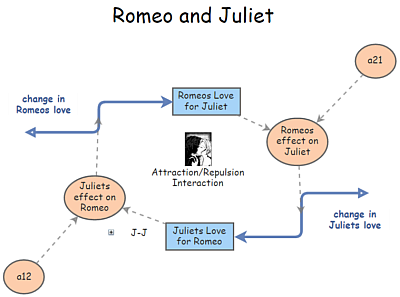
Developing understanding: Models 8-9 [Systems thinking & modelling series]
This is part 13 of a series of articles featuring the book Beyond Connecting the Dots, Modeling for Meaningful Results.
Romeo and Juliet
This example shows that you really can simulate anything through modeling. This model shows the implications of the dynamic relationship of the love between “Romeo and Juliet”.
The implications of the relations between two people can vary drastically.
Need help? See the Model instructions
We hope this model gave you a more comfortable feeling that it is possible to model very intangible things. You will find intangibles to be some of the most influential aspects of some of the models you develop. Don’t shy away from them.
Climate Stabilization Task
The “Climate Stabilization Task” model starts in 1900. In the year 2000 you get the chance to set a new emission target and a nominal time to reach it. Your aim is to have atmospheric CO2 stabilize at about 400 ppmv in 2100.1
Can you get the CO2 levels to stabilize?
Need help? See the Model instructions
| Exercise 2-5 |
|---|
| In working with the model did you notice that if you took too long to reach the new emissions level you selected, there was no way you could ever reach the 400 ppm target? What is it about the interactions that might be responsible? |
Next edition: Developing understanding: Models 10-11.
Article sources: Beyond Connecting the Dots, Insight Maker. Reproduced by permission.
Header image source: Beyond Connecting the Dots.
- Sterman, J.D. (2008). Risk communication on climate: mental models and mass balance. Science 322 (5901): 532–533. ↩







